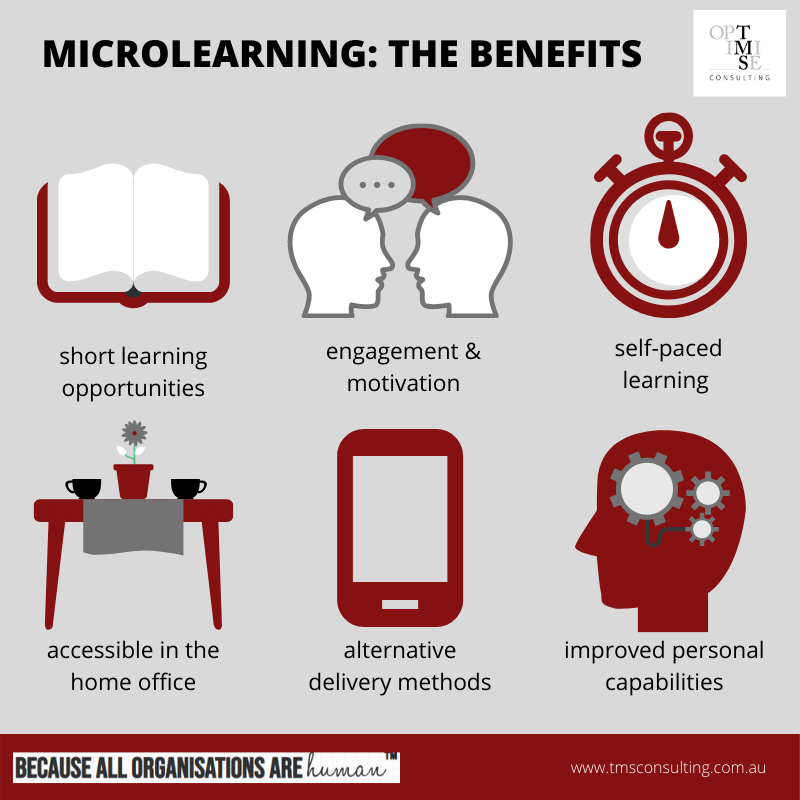Are you and your team currently WFH (working from home)? With the mobilisation of the workforce to home offices, leaders are having to rethink the way they engage staff, maintain momentum and develop new capabilities. This is where microlearning can help.
Microlearning is a unique form of training staff. It refers to short learning units and learning activities that utilise a range of media and can incorporate TED talks, videos, scenarios or articles. It’s also common for microlearning to include online quizzes for healthy competition between co-workers!
The adoption of microlearning initiatives enables participants to receive small, variable sources of information – packaged in 1-5-minute grabs – to convey a singular message. It is most effective when it has a training element and has a performance outcome such as evoking a change in a person’s behaviour. Microlearning information can be staggered over several days or weeks, ensuring easier uptake of content and the building of key learnings. It can supplement, or replace, existing learning and development opportunities for staff to enable bite-sized, alternative delivery methods that are focused on one or two learning objectives at a time.
Participants of microlearning activities take a self-directed approach and choose the time of day that they engage in the learning to fit it around other business as usual activities. And with the utilisation of mobile friendly technology, microlearning can be accessed on the go and from the home office.
 The benefits of microlearning are extensive; it can increase engagement, maintain enthusiasm and motivation, and result in measurable changes in people’s behaviours. This is vitally important during times of uncertainty and stress. Microlearning allows participants to focus on one element and learning objective at a time, via short and subtle delivery, thereby lessening the cognitive load on learners. This can be explained by the ‘spaced learning effect,’ researched by Hermann Ebbinghaus, a German psychologist. The spaced learning effect refers to the time and repetition required for the brain to convert knowledge from short-term or sensory memory (which are limited and decay rapidly) into long-term memory.
The benefits of microlearning are extensive; it can increase engagement, maintain enthusiasm and motivation, and result in measurable changes in people’s behaviours. This is vitally important during times of uncertainty and stress. Microlearning allows participants to focus on one element and learning objective at a time, via short and subtle delivery, thereby lessening the cognitive load on learners. This can be explained by the ‘spaced learning effect,’ researched by Hermann Ebbinghaus, a German psychologist. The spaced learning effect refers to the time and repetition required for the brain to convert knowledge from short-term or sensory memory (which are limited and decay rapidly) into long-term memory.
For our brains to ‘re-wire’ in the way required to embed information, they need breaks in learning, along with continued repetition. This is why micro-learning is especially effective for reinforcing learning, rather than introducing new or complex content. Our brains are not wired for multi-tasking and can only really concentrate on one thing at a time effectively – therefore the presentation of information in sections also avoids cognitive overload. The space created between each learning experience allows information can be effectively processed and moved from short-term into long-term memory.
TMS’ microlearning series on Stephen Covey’s Circle of Control and Influence tool, provides participants with the opportunity to analyse the situations they can positively influence. It supports learners to understand where to focus their energy and attention to become more proactive, rather than wasting energy on things they cannot control.
This is particularly relevant in the current environment, where teams are displaced and there is high levels of uncertainty and change. If you would like to know more about adaptive and responsive ways to support staff during the COVID-19 crisis, then contact TMS on solutions@tmsconsulting.com.au to discuss our range of flexible options.



